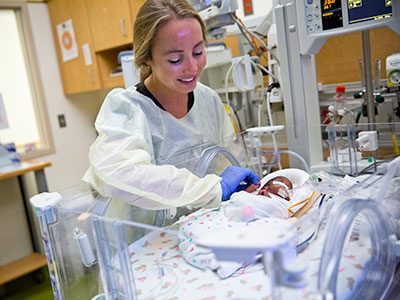Quality improvement initiative reduces vancomycin use in NICU

A quality improvement initiative in the Neonatal Intensive Care Unit (NICU) at Children’s National Hospital led to a significant reduction in treatment with intravenous vancomycin, an antibiotic used for resistant gram positive infections, which is often associated with acute kidney injury.
A quality improvement initiative in the Neonatal Intensive Care Unit (NICU) at Children’s National Hospital led to a significant reduction in treatment with intravenous vancomycin, an antibiotic used for resistant gram positive infections, which is often associated with acute kidney injury. The findings, published in the journal Pediatrics, show the initiative reduced vancomycin use in patients by 66%, and the NICU has sustained the reduction for more than a year.
Vancomycin is a broad-spectrum antibiotic often used to treat methicillin-resistant Staphylococcus aureus (MRSA) infection. It’s one of the most commonly prescribed antibiotics in NICUs, but its overuse poses an increased risk of morbidity. Benchmarking data showed that in 2017, vancomycin use at Children’s National Hospital was significantly higher than use at peer institutions, suggesting there was likely an opportunity to optimize use of this drug.
The intervention program was led by Rana Hamdy, M.D., M.S.C.E., M.P.H., an infectious diseases specialist at Children’s National, Lamia Soghier, M.D., medical unit director of the Children’s National NICU, and other team members from neonatology, infectious diseases, pharmacy, nursing and quality improvement. The team accomplished the prescribing reduction by sequentially implementing a four-step approach involving interdisciplinary team building and provider education, pharmacist-initiated 48-hour time-outs, clinical pathway development and prospective audit with feedback.
“Our interdisciplinary quality improvement team was devoted to this project and implemented interventions that, early on, led not only to reduction in vancomycin use, but to better outcomes in our patients with fewer episodes of vancomycin-associated acute kidney injury,” said Dr. Hamdy. “This led to early buy-in from the prescribers, ultimately changing the culture of antibiotic prescribing in the NICU.”
Following the NICU’s intervention program to improve patient safety, vancomycin use in patients decreased from 112 days of therapy per 1,000 patient-days to 38 days of therapy per 1,000 patient-days. During the intervention program, the researchers noted that this was “the first work to show a significant change in vancomycin-associated acute kidney injury in neonates.”
Four key interventions were sequentially implemented to successfully achieve and sustain the reduction in vancomycin use. Intervention 1 was the development of an interdisciplinary and provider education team that addressed institutional antibiotic prescribing practices. Intervention 2, a pharmacist-initiated 48-hour time-out, involved clinical pharmacists identifying patients who have been on antibiotics for ≥ 48 hours and encouraged their providers to either discontinue vancomycin or to switch to a narrow-spectrum antibiotic. Intervention 3 consisted of the development of new clinical pathways including discontinuing vancomycin in infants at low risk for MRSA. Lastly, intervention 4, antimicrobial stewardship program (ASP) prospective audit and feedback, involved an ASP member reviewing all NICU vancomycin orders and issuing appropriate recommendations for NICU providers and pharmacists to be carried out within 24 hours.
This project was taken on as part of Children’s National Quality Improvement and Leadership Training (QuILT) course sponsored by the Quality & Safety Department. This notable work was highlighted in the 2019 annual Quality and Safety report and by the Magnet® program as an exemplary example of nursing-physician partnership working to improve patient care.
The associated article, “Reducing Vancomycin Use in a Level IV Neonatal Intensive Care Unit,” will be published July 1 in Pediatrics. The lead author is Dr. Rana Hamdy, an infectious diseases specialist and director of the Antimicrobial Stewardship Program. Twenty notable co-authors are also from Children’s National.










